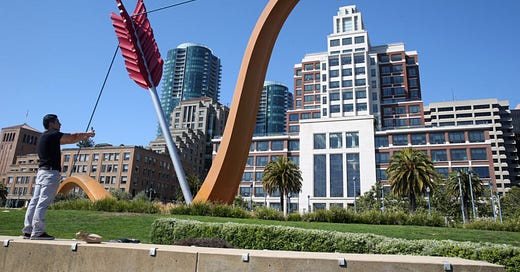I will admit that I did not think much about the giant bow and arrow along the Embarcadero when I would pass by it on my bike or the train. I did wonder why the arrow was pointing downward. Pointing to the sky would make more sense to me, but I thought that there was likely a good reason. I also did not realize that it was titled “Cupid’s Span.” Here’s the reason why it is facing toward the ground:
Initially, the artists had envisioned placing the bow with its arrow pointed majestically towards the heavens. But upon further contemplation, Coosje van Bruggen realized that this positioning felt “too stiff and literal.” Thus, they embarked on a creative journey, seeking to change the focus of attention and explore uncharted perspectives that lay beyond the obvious.
The stroke of genius came when they decided to invert the bow, transforming the sculpture into a captivating symbol of poetic depth. Perched gracefully upon a hill, Cupid’s Span now feeds from the mythological tale of Eros, the god of love, who shot his arrow into the earth, bringing fertility and life. By partially burying the arrowhead and the central part of the bow, the sculpture took on a new life, brimming with symbolism and hidden meanings.
This transformation opened up a myriad of interpretations, some of which I had never considered before. As I stood there, gazing up at this remarkable installation, it occurred to me that it resembled a magnificent ship sailing into the vastness of the bay. The bowed shape evoked thoughts of a grand suspension bridge, echoing the surrounding architecture and landscape. Claes and Coosje envisioned this design as the perfect accompaniment to the site, an elegant and thoughtful addition to San Francisco’s waterfront.
One can’t help but appreciate the story behind this magnificent piece even more when learning that it was commissioned by none other than the founders of GAP, Doris, and Donald Fischer. Completed in 2002, Cupid’s Span became not only a stunning addition to San Francisco’s public art scene but also a symbol of love and unity, a timeless representation of the city’s soul.
Claes Oldenburg and Coosje van Bruggen were married and were an artist and curator/art historian respectively. Claes was a leading voice in the Pop Art movement. Here’s a great article about Oldenburg’s legacy and his massive structures:
American sculptor Claes Oldenburg was best known for his large-scale replicas of everyday objects. He believed that his colossal public art projects were more than mere celebrations of the mundane, as he is frequently associated with the Pop Art movement of the 1960s. Like Andy Warhol and other Pop artists, Oldenburg found inspiration in ordinary consumer objects, charging them with vigorous human connotations.
Oldenburg’s sculptures and drawings blended a witty and satirical approach toward consumer products with rigorous construction details and proportion handling at massive scales. He was the creator of sculptures like the huge upside-down ice cream cone on the roof of a shopping gallery in Cologne; the Flying Pins in Eindhoven, the Cupid’s Span along San Francisco Bay; the iconic 45-foot tall Clothespin in Philadelphia; and the baseball bat sculpture titled Batcolumn in Chicago – just to name a few remarkable sculptures of his.




